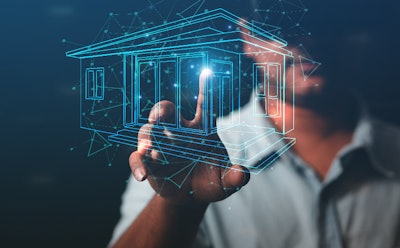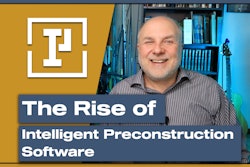
There is that sinking feeling that a contractor gets when they submit a project bid only to find out they are their pricing was far lower than competitors.
Two questions immediately come to mind—"what did we miss?” And—“how much is this going to cost me.”
“One of our investors has a glazing business,” Togal.AI President and Co-Founder Patrick Hughes said in an April 2023 discovery call. “He won a bid and realized he was over $1 million low on his numbers. Why was he $1 million low? It turns out he missed an entire floor on the takeoff. He invested in Togal.AI both as an investor and as a user confident that it will be a lot cheaper than missing an entire floor and losing another million.”
Founded in 2019 and funded in part by a Florida contractor, Togal.AI’s most predictable claim to return on investment is, however, time saved through AI-driven takeoffs so estimators can bid more work. Togal.AI can identify architectural features, measure spaces, capture linear measures for materials, automating away hours of manual work. Togal.AI sources say their customers have been able to bid 40 percent more work while increasing focus on value engineering, scoping and bid leveling.
Other companies have offerings to different parts of the market—Patabid launched Quantify, which uses AI to automate takeoffs for mechanical, electrical and plumbing (MEP) contractors, in March of 2022. And Zetane in February of 2022 announced an initiative with its customer, Pomerleau that will similarly automate takeoff while also roundtripping data from completed projects to provide insights into whether or how similar projects or projects with the same owner should be bid in the future.
“They have massive amounts of data against the original bid that you had, including data on change orders,” Zetane CEO Guillaume Herve’ said. “There are ways today in AI to retroactively look at that and tell us, ‘well, you can expect these areas to be changed.’ In construction 20 percent of the project probably drives 80 percent of the cost and the risk. Knowing which 20 percent that is gives you a proactive way to assess risk, cost, or for the contractor, success or failure.”
Growing Construction AI Startup
At the time of our April IRONPROS debriefing with Hughes, the company had a complement of 40 including two selling product to new customers. But contractors have more ways to buy than talking with a salesperson—they can subscribe using a credit card online, although Hughes stresses they work hard to maximize the number of customers coming in this route that also opt for a brief training and orientation session.
“They are really more productive if we can get at least 15 minutes with someone just to show them some of the basics,” Hughes said. “But everyone has a different baseline. We are building out some self-guided tours so a user, in under four minutes can take a tour and learn the features.”
Many contractors may also become Togal.AI customers through partnerships with a number of estimating software product vendors including ConstructConnect and eTakeoff.
And what does Togal.AI bring to the table that helps them ride into contractor organizations with such esteemed estimating software partners? Quite a bit. The web-based takeoff tool enables vertical construction users to upload and digest a broad spectrum of file types—JPEG, TIF, PNG, and not only provide manual takeoff functions similar to traditional software, but an AI trained for architectural floor plans. This AI can recognize, capture and quantify net area, gross area, linear counts, walls, wall types, object counts and more, automatically classifying room types and wall types.
Automating mistakes is not an effective tactic, and Hughes stressed that the AI algorithms have been trained for accuracy as well as speed.
“In that AI functionality we are 98% accurate,” Hughes said. “We were disciplined to not release until we were accurate as a human or better. Humans were 97% accurate.”
Togal.AI also enables collaboration because more than one user can view and interact with a single document at the same time in a traceable, auditable environment. This improves revision control and ultimately reduces errors and oversights.
“An infinite number of people can be on that same document,” Hughes said. “A lot of customers find they don’t have to share plans by email. This helps with version control and helps save time. If there is a question about toilet installation, here is how you do it—it is all collaborative and live. Our customer success team can teach that to folks.”
ChatGPT for Construction Documents
While ChatGPT, the trendy generative AI, is getting attention for its ability to create original text on broad topics, Togal.AI is harnessing it to answer specific questions about plans and construction documents.
“Our number one priority is continuing to build an intuitive takeoff software that anybody can log on and understand in five to ten minutes,” Hughes said. “We combine this with a lot of deep AI and very sophisticated algorithms that help enhance the end user’s efficiency. We are doing some really complicated stuff. It is important to make that easy and consumable for the user.”
In April, Togal.AI announced it had harnessed Chat GPT as a natural language search tool for construction documents housed in the Togal.AI application.
“We took ChatGPT and are making that easy and adoptable in construction documents,” Hughes said. “If we do that, then we continue to grow our customers, get new customers, expand in the US and internationally and sign partnerships.”
Togal.AI Tech Stack
Togal.AI is a multitenant software-as-a-service (SaaS) application that resides on Amazon Web Services (AWS). According to Togal.AI Head of Operations and Investor Relations Karlie LaCroix, the application relies on React.js on the frontend, and geck.gl as a rendering engine. The back and harnesses node.js and a PostgreSQL database. Other heavy lifting in the application makes heavy use of various components of the AWS environment including:
- AWS Lambda to convert PDFs to images
- AWS Textract for optical character recognition (OCR)
- AWS Autoscaling for container management
- AWS g4dn to run the machine learning interface and P3 for training the models.
Some of the secret sauce behind Togal.AI though is proprietary—specifically a C++ postprocessing code to ensure predictions are fast, precise and intuitive.
Customer-facing code is shipped multiple times a week.
Togal.AI Pricing and Market
Most types of vertical building contractors can be a fit for Togal.AI, according to Hughes, including general contractors, trade contractors, flooring contractors, drywall contractors and others. The company will lean on its first-in market status as a moat against competitors as it expands to new use cases and contracting environments.
“We have optimizing it more for civil, heavy and infrastructure on the road map,” Hughes said. “We are lucky … we were issued three patents on the use of AI for this functionality. We enjoy that first mover advantage The competition is people implementing tech or not implementing technology.”
Togal.AI is priced on a per-user monthly subscription, with volume discounts coming at about 10 users, but a contractor may want to start trying to negotiate at eight users.
Who is Togal.AI a fit for? Hughes said the company scales all the way up to multi-billion-dollar major contractors like Clark Construction. But contractors with as little as $10 million or even $5 million in annual construction volume may find a fit.
BOTTOM LINE: Grand and expansive applications for artificial intelligence make for better science fiction, but precise and focused ones right now seem to drive more reliable business results. Togal.AI has this figured out and has applied AI to one of the first pain points contractors experience during a project lifecycle in ways that should reliably deliver measurable ROI. The application is usable by a broad spectrum of horizontal building contractors, and IRONPROS will be following the company to track its progress in addressing nonbuilding construction. Replacing and improving on labor-intensive, time consuming tasks that are mission critical is a smart way to apply AI. The addition of ChatGPT for natural language search is also interesting, but may be more of an incremental improvement on traditional search queries.















